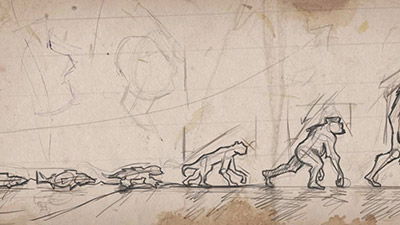
“Living Fossils” with Massive Genome: Our Closest Living Fish Ancestors?
Recently I wrote about a unique Australian creature that was in the news—the platypus. Well, another creature from my home Down Under is making headlines. This one isn’t as well known as the platypus, but it’s also unique (for instance, it has both gills and a lung). What is it? It’s the Australian lungfish! But why is it in the news?
It’s the largest animal genome sequenced to date at a stunning 43 billion base pairs (to put that in perspective, our genome has “only” 3 billion base pairs).
Scientists just finished mapping the lungfish genome (DNA sequence). It’s the largest animal genome sequenced to date at a stunning 43 billion base pairs (to put that in perspective, our genome has “only” 3 billion base pairs). Of course, scientists are quick to tie this into supposed evolutionary ancestry as lungfish are believed to be very ancient “living fossils” (appearing in the fossil record 400 million years ago by evolutionary dating, yet remaining very similar to their ancestors . . . almost as if they are part of the same created kind, created just a few thousand years ago!).
It’s believed lungfish are our closest living fish ancestors and “within the Australian lungfish's giant haystack of genes are clues to how animals made the transition from aquatic to terrestrial.” But does this new study actually confirm such an anti-biblical idea?
Here’s what AiG geneticist Dr. Georgia Purdom says about this new study:
The lungfish is a unique animal that has both gills and a lung. This allows it to breathe in water (which it does most of the time) and breathe air when conditions are dry. The now known lungfish genome is a whopping 43 billion base pairs, making it the largest known animal genome. These are all observable facts.
Evolutionists have taken these observable facts and interpreted them according to an evolutionary worldview based on the unobservable past. They believe the lungfish is some kind of “strange in-between ‘living fossil’” that can give us insights into our fishy ancestor that went from water to land and gave rise to all mammals and birds today. It now even takes the title of our “closest living fish relative.”
Supposedly the lungfish genome reveals some of the “evolutionary innovations” that were needed to help our ancestor go from water to land, like genes that allow the lungfish to detect airborne odors. The evolutionists call these genes “additions” to the lungfish genome and believe they helped with the transition. But again, the presence of these genes is an observable fact; it doesn’t explain the origin of those genes.
They also believe the lungfish genome is so big because multiple sections of it were copied, and this gave it more raw material to work with to come up with these new genes by “stumbl[ing] into random gene mutations that just happen to help [it] survive better.” It might be a nice-sounding story but that’s all it is—story, fictitious story. Mutations simply don’t generate novel genetic information. Instead, they degrade the information that is already present.
Instead, God designed the lobe-finned fish kind (that the lungfish belongs to) with a vast genome that allows it to survive in conditions that change. No story, just truth!
When the observational evidence is stripped of the evolutionary interpretation imposed on it, we don’t find evidence for evolution but facts that are consistent with the Bible’s history. As the researchers point out, the imaginary leap from water to land would have involved “a number of evolutionary innovations including airbreathing, limbs, posture, prevention of desiccation, nitrogen excretion, reproduction, and olfaction,” and they believe somehow our fishy ancestor “struck enough genetic jackpots” to evolve all these things! As AiG anatomist Dr. David Menton would say, “wow, the dumb luck!”
By the way, because the fins have bones loosely embedded in the muscle, evolutionists believe these fish were evolving legs. But the bone structure is nothing like that of an articulated limb.
Such a story is more than just fishy—it’s impossible!
Get More Answers on Answers News
I discussed this item yesterday on Answers News with cohosts Dr. Georgia Purdom, and Bodie Hodge. Answers News is our twice-weekly news program filmed live before a studio audience here at the Creation Museum and broadcast on my Facebook page and the Answers in Genesis Facebook page. We also covered the following topics:
- Do you need a “spiritual director”?
- Does a genetic switch lead to rapid evolution?
- First “anti-abortion” decision of the Supreme Court?
- And more!
Watch the entire episode of Answers News for January 25, 2020.
Be sure to join us each Monday and Wednesday at 2 p.m. (ET) on my Facebook page or the Answers in Genesis Facebook page for Answers News. You won’t want to miss this unique news program that gives science and culture news from a distinctly biblical and Christian perspective.
Thanks for stopping by and thanks for praying,
Ken
This item was written with the assistance of AiG’s research team.
Most Recent News
-
July 25, 2024 from Ken Ham Blog
One scientist shares that this new study “really highlights that what we think as a separate Neanderthal lineage really was more interconnected with our ancestors.”
-
July 22, 2024 from Ken Ham Blog
According to a new study, in just 300 million years, earth managed to become hospitable to life and life managed to organize and emerge.

Answers in Genesis is an apologetics ministry, dedicated to helping Christians defend their faith and proclaim the good news of Jesus Christ.
- Customer Service 800.778.3390
- © 2024 Answers in Genesis



